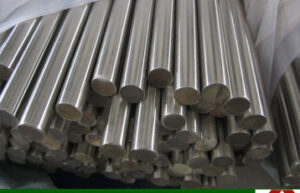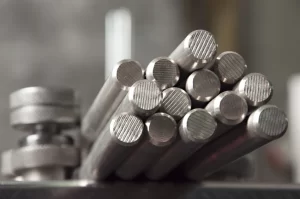Stainless steel, a marvel of modern metallurgy, owes its remarkable properties to the intricate blend of alloying elements within its structure. Among the diverse stainless steel grades, the composition of 410 stainless steel stands out as a cornerstone of its performance. In this comprehensive article, we embark on a journey of metallurgical exploration, dissecting the precise composition of 410 stainless steel, unraveling the significance of each element, and understanding how this alloy’s makeup shapes its mechanical, corrosion-resistant, and machinability attributes.
1. The Enigma of Stainless Steel Alloys
 Stainless steel, revered for its corrosion resistance, strength, and aesthetic appeal, encompasses an array of alloys, each with a distinct composition. In this pursuit, we unravel the enigma behind the composition of 410 stainless steel and its consequential effects.
Stainless steel, revered for its corrosion resistance, strength, and aesthetic appeal, encompasses an array of alloys, each with a distinct composition. In this pursuit, we unravel the enigma behind the composition of 410 stainless steel and its consequential effects.
2. Decoding the DNA: Elements in 410 Stainless Steel
410 stainless steel’s composition includes a delicate balance of essential elements:
- Chromium (Cr): 11.5% – 13.5%
- Carbon (C): 0.08% – 0.15%
- Manganese (Mn): Up to 1.0%
- Silicon (Si): Up to 1.0%
- Phosphorus (P): Up to 0.04%
- Sulfur (S): Up to 0.03%
Each element contributes to the alloy’s mechanical, structural, and corrosion-resistant properties.
3. Chromium: The Heart of Corrosion Resistance
Chromium reigns supreme in 410 stainless steel, driving its corrosion-resistant nature. As an alloying element, chromium forms a protective oxide layer on the steel’s surface, shielding it from corrosive agents.
4. Carbon: Crafting Hardness and Strength
Carbon, a cornerstone of 410 stainless steel’s composition, enhances hardness and strength through the formation of martensitic microstructures upon heat treatment.
5. Manganese and Silicon: Structural Balancing Act
Manganese and silicon play supporting roles, contributing to the alloy’s structural stability and improving its mechanical properties.
6. Phosphorus and Sulfur: The Elements in Trace
Present in trace amounts, phosphorus and sulfur subtly influence the alloy’s machinability, brittleness, and overall performance.
7. Influence on Mechanical Properties
The interplay of elements in 410 stainless steel culminates in remarkable mechanical properties:
- Hardness: Elevated carbon content contributes to hardness.
- Strength: Chromium and carbon synergize to enhance strength.
- Ductility: Manganese and silicon aid in maintaining a balance between hardness and ductility.
8. Corrosion Resistance and Passive Film
 The composition of 410 stainless steel, particularly its high chromium content, facilitates the formation of a passive oxide film. This film acts as a shield against corrosive agents, contributing to the alloy’s resistance to degradation.
The composition of 410 stainless steel, particularly its high chromium content, facilitates the formation of a passive oxide film. This film acts as a shield against corrosive agents, contributing to the alloy’s resistance to degradation.
9. Machinability and Fabrication
The composition also affects 410 stainless steel’s machinability and fabricability. Its lower work hardening rate compared to austenitic stainless steels makes machining operations more manageable.
10. Challenges and Considerations
While the composition of 410 stainless steel imparts numerous advantages, it also poses challenges in terms of corrosion resistance, particularly in aggressive environments. Understanding these limitations is crucial for selecting the appropriate stainless steel grade for specific applications.
11. Frequently Asked Questions (FAQ)
Q1: What makes chromium a crucial element in 410 stainless steel?
A1: Chromium forms a protective oxide layer on the steel’s surface, enhancing its corrosion resistance and enabling it to withstand corrosive environments.
Q2: How does carbon content influence the hardness of 410 stainless steel?
A2: Higher carbon content contributes to the formation of martensitic structures, increasing hardness upon heat treatment.
Q3: What role do manganese and silicon play in 410 stainless steel’s composition?
A3: Manganese and silicon enhance structural stability and mechanical properties, aiding in maintaining a balance between hardness and ductility.
Q4: Can the presence of phosphorus and sulfur impact 410 stainless steel’s performance?
A4: Yes, trace amounts of phosphorus and sulfur can affect machinability, brittleness, and overall performance of 410 stainless steel.
Q5: What considerations are important when selecting a stainless steel grade based on composition?
A5: Consider factors such as corrosion resistance, mechanical properties, temperature, and environmental conditions to determine the most suitable stainless steel grade for specific applications.
Conclusion
The composition of 410 stainless steel is an intricate tapestry of alloying elements, each contributing to its unique array of properties. This metallurgical symphony, guided by the percentages of chromium, carbon, manganese, silicon, phosphorus, and sulfur, crafts a stainless steel grade that embodies hardness, strength, corrosion resistance, and machinability. Understanding the profound impact of these elements empowers engineers and designers to harness the attributes of 410 stainless steel effectively, tailoring its application to diverse industries with precision and finesse.
